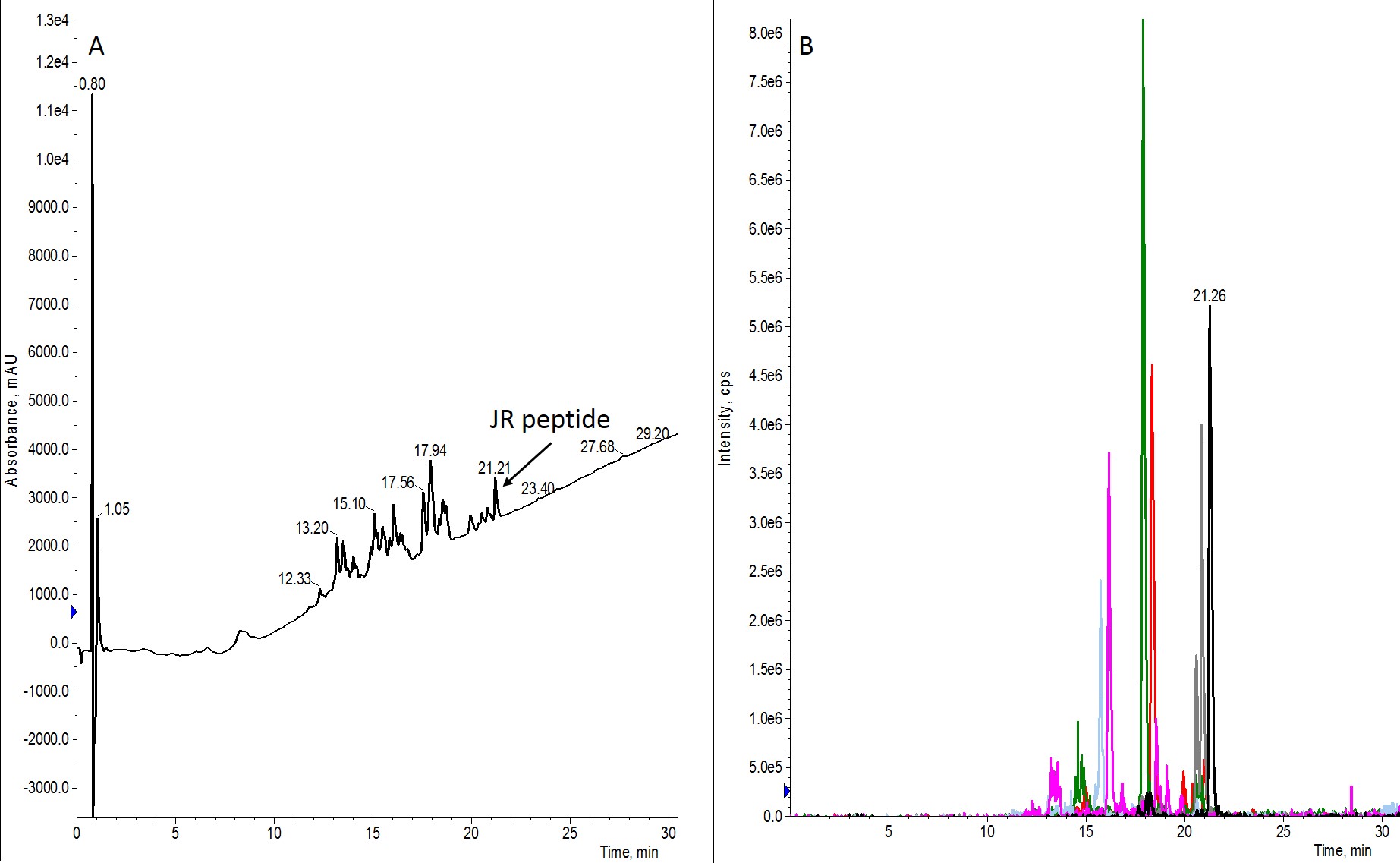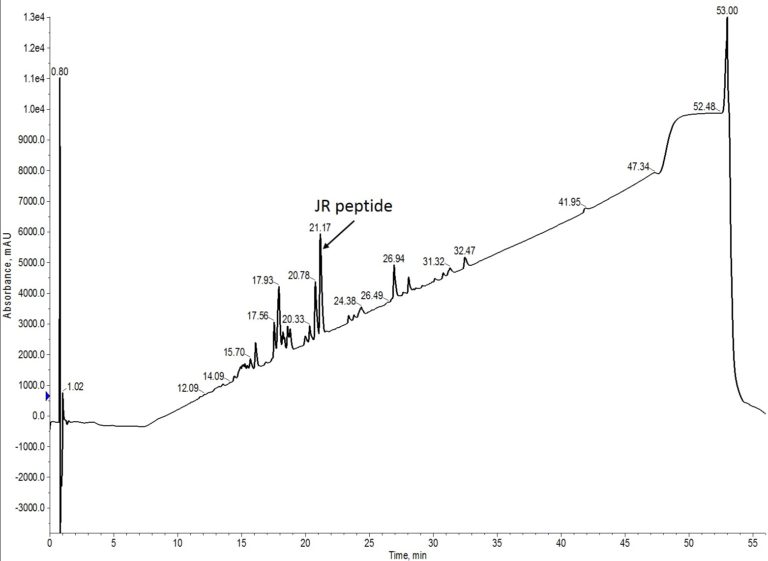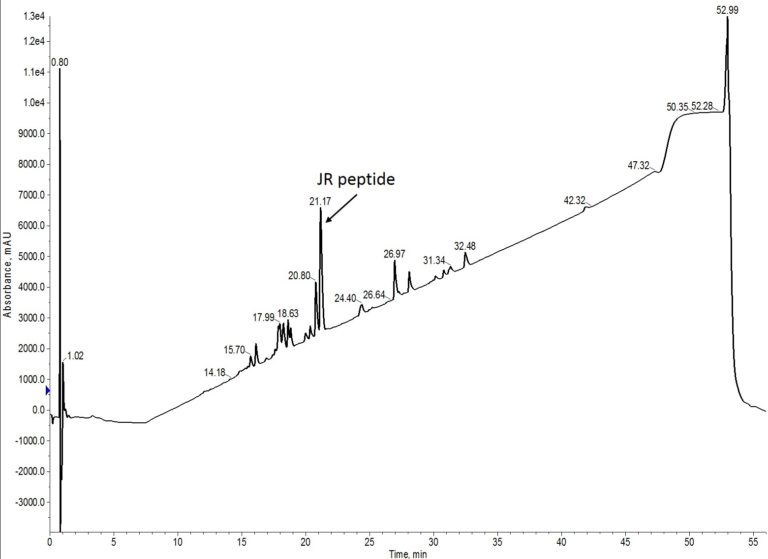Big pharmaceutical companies have begun to refocus their efforts towards peptide discovery projects with the hopes of identifying the next big peptide drug. There are often hundreds to thousands of peptides synthesized as part of these efforts, demanding parallel synthesis platforms and room temperature peptide synthesis protocols.
Previously, I identified a minimum number of amino acids equivalents required to ensure a high quality microwave synthesis. Conducting synthesis at room temperature will certainly require different conditions than microwave heating. Let’s explore how the number of equivalents will impact the synthesis results.
Now I’ll admit, I am not the most experienced when it comes to room temperature synthesis. Almost all the peptides I have ever synthesized were with microwave assistance. But the chemistry is the same, and I’ve read a few papers that describe the exact conditions, so let’s give it a go.
I decided to synthesize a short, albeit difficult peptide (sequence: WFTTLISTIM) for this experiment, known as the JR sequence. Even with microwave heating a des-Trp deletion sequence is commonly observed.
I decided to use 3 equivalents of amino acid and coupling reagents for the first synthesis. This is the fewest equivalents necessary for a reasonable microwave assisted synthesis. I programmed my Biotage® Initiator+ Alstra™ to use 0.5 M amino acid solution, 0.5 M DIC and 0.5 M OxymaPure with 40 min single couplings and pushed play, Figure 1.

Figure 1: Crude analytical HPLC (A) and extract ion chromatogram (B) for the JR 10-mer sequence synthesized using 3 equivalents of amino acid.
As expected, this synthesis is pretty messy. There is some desired product present, but deletion and truncation products represent the majority of the crude peptide content (see Table 1 for peak assignments). The UV absorbance suggests that the most prevalent species in the crude solution is a des-Trp deletion sequence. Extracting the parent mass for each of the identified deletion sequences from the total ion chromatogram aids in peak assignment, Figure 1B.
| Peptide Sequence | Molecular Weight | Retention time (min) | XIC Chromatogram color |
|---|---|---|---|
| WFTTLISTIM | 1212.47 | 21.21 | black |
| WFTLISTIM | 1111.36 | 20.78 | grey |
| FTTLISTIM | 1026.26 | 17.94 | red |
| FTLISTIM | 925.15 | 17.56 | green |
| TTLISTIM | 879.1 | 16.12 | magenta |
| TLISTIM | 777.9 | 15.70 | light blue |
Table 1: Peptide sequences observed in crude analtyical HPLC-MS for JR peptide synthesized at room temperature.
For the second synthesis I used 5 amino acid equivalents. I typically use 5 equivalents in my microwave assisted syntheses to ensure the highest quality crude peptide product, especially when using low cost amino acids. I made a point to keep the amino acid concentration, synthesis scale, and coupling reaction time the same as the previous synthesis in order to make a more fair comparison, Figure 2.

Figure 2: Crude analytical HPLC for the JR 10-mer peptide synthesized using 5 equivalents of amino acid.
First and foremost, the overall chromatographic pattern is very similar for the second synthesis when compared to the first. Using more amino acid equivalents did improve the synthesis outcome and the intact peptide is now the majority component of the crude mixture. However, the des-Trp and des-Thr deletion products still represent a significant fraction of the overall crude mixture. There is definitely room for improvement.
For the final synthesis I doubled the amino acid equivalents to 10. I often find these conditions when researching protocols for specific peptides. As with the previous two synthesis efforts, I used 0.5 M amino acid solution with 0.5 M coupling reagents and single couplings for 40 minutes, Figure 3.

Figure 3: Crude analytical HPLC for the JR 10-mer peptide synthesized using 10 equivalents of amino acid.
These conditions have provided the best results thus far. The fraction of desired peptide increases with a significant reduction in the other deletion products. The most prevalent contaminant is the des-Thr sequence. This isn’t too surprising though. Coupling an amino acid to itself is inherently challenging, even for amino acids with small side chains.
Although none of these protocols yielded a peptide with single peak crude purity, each amino acid equivalent increase resulted in a more pure crude product than the previous synthesis. There are several strategies to improve this synthesis further including:
- If cost is a concern, I would first increase the reaction time, which is often applied for difficult couplings at room temperature.
- Alternatively, using a double coupling strategy could also increase the crude purity.
My curiosity has piqued so I’ll be working more with this peptide in the near future. I’ll be sure to let you know what conditions provide single peak crude purity.
To learn more about how Biotage tools can enable synthesis of difficult peptides, follow the link below.

 Organic Workflow
Organic Workflow Peptide Workflow
Peptide Workflow Scale-Up Flash Purification
Scale-Up Flash Purification  Sample Preparation
Sample Preparation Biomolecule Purification
Biomolecule Purification Oligo synthesis
Oligo synthesis Scavengers and Reagents
Scavengers and Reagents Service & Support
Service & Support Accessories & Spare parts
Accessories & Spare parts Investors
Investors Reports & News
Reports & News The Share
The Share Corporate Governance
Corporate Governance Calendar
Calendar Sustainability
Sustainability Our Offering
Our Offering Our History
Our History Our Locations
Our Locations Leadership
Leadership